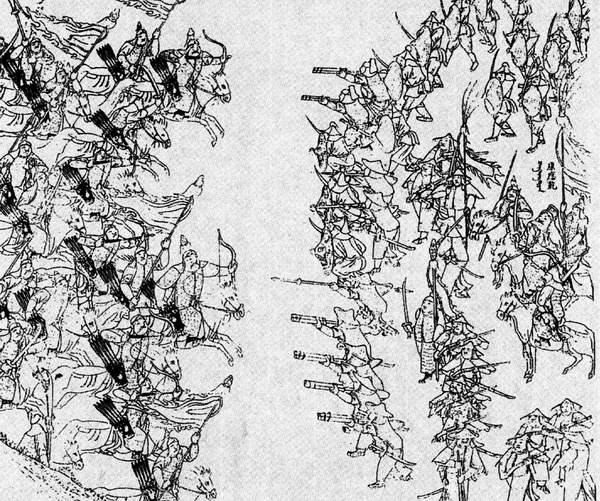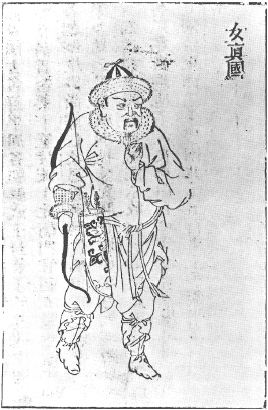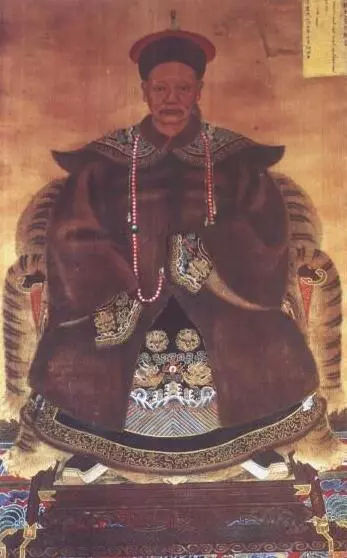|
Daišan
Daišan (Manchu: ; 19 August 1583 – 25 November 1648) was an influential Manchu prince and statesman of the Qing dynasty. Family background Daišan was born in the Manchu Aisin Gioro clan as the second son of Nurhaci, the founder of the Qing dynasty. His mother was Nurhaci's first consort, Lady Tunggiya (佟佳氏). He was an older half-brother of Nurhaci's successor, Hong Taiji. Career Nurhaci's reign During Nurhaci's campaign against the Ula clan and its ''beile'' Bujantai in 1607, Daišan distinguished himself on the battlefield by assisting Šurhaci and Cuyen. For his efforts, he was granted the title of "Guyen Baturu" () (literally: "exploring hero"). In 1613, Daišan again distinguished himself on the battlefield in Nurhaci's campaign against the Ula clan. In 1616, when Nurhaci declared himself khan and established the Later Jin dynasty, Daišan was the first selected as '' beile'' of a special rank by Nurhaci to assist in administration. These four ''beile'' ... [...More Info...] [...Related Items...] OR: [Wikipedia] [Google] [Baidu] |
Nurhaci
Nurhaci (14 May 1559 – 30 September 1626), also known by his temple name as the Emperor Taizu of Qing, was the founding khan of the Jurchen people, Jurchen-led Later Jin (1616–1636), Later Jin dynasty. As the leader of the House of Aisin-Gioro, Nurhaci reorganized and united various Jurchen tribes (the later "Manchu people, Manchu"), consolidated the Eight Banners military system, and eventually launched attacks on both the Ming dynasty, Ming and Joseon dynasties. His conquest of Ming dynasty's northeastern Liaodong region laid the groundwork for the Qing conquest of the Ming by his descendants, who proclaimed the Qing dynasty in 1636. He is also generally credited with ordering the creation of a new written script for the Manchu language based on the Mongolian script, Mongolian vertical script. Name and titles Nurhaci is written as in Manchu language. Some suggest that the meaning of the name in the Manchu language is "the skin of a wild boar". Another explanation is "brav ... [...More Info...] [...Related Items...] OR: [Wikipedia] [Google] [Baidu] |
Mandahai
Mandahai ( mnc, ᠮᠠᠨᡩᠠᡥᠠᡳ, ; 30 April 1622 – 15 March 1652), was an imperial prince of the Qing dynasty and one of Nurhaci's grandson. He was the seventh son of Daišan and in 1649 he inherited his father's princedom. He was posthumously honoured as Prince Xunjian of the First Rank (巽簡親王). Life Mandahai was born in the Aisin Gioro clan on 30 April 1622 as the seventh son of Daišan. His mother was Daišan's princess consort Lady Yehe Nara, who also bore the eighth son, Hūse. He would join his father and uncles in military campaigns. He accompanied his father to the siege of Jinzhou in 1640. In the following year, he was given the title of bulwark duke. He participated in the Battle of Shanhai Pass under Dorgon, which was a decisive battle leading to the beginning of Qing dynasty rule in China proper. Mandahai was promoted for his services to the rank of Prince of the Fourth Rank in 1644. In the next year, he joined his uncle, Ajige, in pursuit o ... [...More Info...] [...Related Items...] OR: [Wikipedia] [Google] [Baidu] |
Cuyen
Cuyen (; 1580 – 14 October 1615) was a Manchu prince and eldest son of the Later Jin ruler Nurhaci, the early patriarch of the Qing dynasty. An accomplished warrior, Cuyen was instrumental in the consolidation of Nurhaci's authority among rival Jurchen clans. He also served as the primary civil administrator for intermittent periods in the regime founded by Nurhaci. However, he eventually lost favour with his father because he tried to cast sorcery spells against other princes. He was placed in solitary confinement and died in captivity a few years later. Early life Cuyen was born in 1580, somewhere in the present-day Jilin province in northeastern China, to a prominent family of Jianzhou Jurchens. He is the grandson of Taksi and eldest son of Nurhaci, who at the time was just beginning to rise to prominence in the Jurchen tribe he belonged. Cuyen's mother was Hahana Jacing of the Tunggiya clan, Nurhaci's primary wife, who also gave birth to the prince Daišan. Cuyen was ... [...More Info...] [...Related Items...] OR: [Wikipedia] [Google] [Baidu] |
Prince Li (禮)
Prince Li of the First Rank (Manchu language, Manchu: ; ''hošoi doronggo cin wang''), or simply Prince Li, was the title of a Royal and noble ranks of the Qing dynasty#Rule of inheritance, princely peerage of the Manchu people, Manchu-led Qing dynasty of China. It was also one of the Aisin Gioro#Iron-cap princes and their descendants, 12 "iron-cap" princely peerages in the Qing dynasty, which meant that the title could be passed down without being downgraded. The first bearer of the title was Daišan (1583–1648), the second son of Nurhaci, the founder of the Later Jin (1616–1636), Later Jin dynasty. He was awarded the title in 1636 by his half-brother, Hong Taiji, who succeeded their father to the Later Jin throne and who later founded the Qing dynasty. The peerage was renamed to Prince Xun of the First Rank (Prince Xun) in 1651 during the reign of the Shunzhi Emperor, and to Prince Kang of the First Rank (Prince Kang) in 1659, before it was renamed back to Prince Li of the Fi ... [...More Info...] [...Related Items...] OR: [Wikipedia] [Google] [Baidu] |
Prince Ying (穎)
Prince Ying of the First Rank, or simply Prince Ying, was the title of a princely peerage used in China during the Manchu-led Qing dynasty The Qing dynasty ( ), officially the Great Qing, was a Manchu-led Dynasties of China, imperial dynasty of China and an early modern empire in East Asia. The last imperial dynasty in Chinese history, the Qing dynasty was preceded by the ... (1644–1912). The first bearer of the title was Sahaliyan (1604–1636), the third son of Daišan and a grandson of Nurhaci, the founder of the Qing dynasty. The peerage was created in 1636 when Sahaliyan was posthumously awarded the title "Prince Ying of the First Rank" by his uncle Huangtaiji, Nurhaci's successor. Sahaliyan's eldest son, Adali (1624–1643), inherited the peerage and became the second Prince Ying. In 1643, after Huangtaiji's death, Adali and others plotted to replace Huangtaiji's designated successor, Fulin, with another prince, Dorgon. However, the plot was exposed and ... [...More Info...] [...Related Items...] OR: [Wikipedia] [Google] [Baidu] |
Prince Qian
Prince Qian of the Second Rank, or simply Prince Qian, was the title of a princely peerage used in China during the Manchu-led Qing dynasty (1644–1912). As the Prince Qian peerage was not awarded "iron-cap" status, this meant that each successive bearer of the title would normally start off with a title downgraded by one rank ''vis-à-vis'' that held by his predecessor. However, the title would generally not be downgraded to any lower than a ''feng'en fuguo gong'' except under special circumstances. The first bearer of the title was Wakeda (瓦克達; 1606–1652), Daišan's fourth son and a grandson of Nurhaci (the founder of the Qing dynasty). In 1651, Wakeda was granted the title "Prince Qian of the Second Rank" by the Shunzhi Emperor. The peerage was discontinued in 1698 after the Kangxi Emperor stripped Lioyung (留雍; Wakeda's son) of his title for committing an offence. However, the Qianlong Emperor restored the peerage in 1778 and granted it to Dongfu (洞福; Lioyung ... [...More Info...] [...Related Items...] OR: [Wikipedia] [Google] [Baidu] |
Manggūltai
Manggūltai (; ; 1587 – 11 January 1633) was a Manchu noble and an important military and political leader in the early years of the Qing dynasty. He helped Hong Taiji consolidate his power by handing over his Plain Blue Banner to Taiji's. He died when he was 45 to 46 years old in 1633. Family background Manggūltai was born in the Manchu Aisin Gioro clan as the fifth son of Nurhaci, the founder of the Qing dynasty. His mother was one of Nurhaci's primary consorts, who was from the Fuca clan. He was an older half-brother of Nurhaci's successor, Hong Taiji. Career Nurhaci's reign When Nurhaci assumed the title of Khan in 1616, Manggūltai was named one of the ''Four Senior Beile'', to assist Nurhaci's administration. The other three ''beile''s were Daišan, Amin, and Hong Taiji. Starting in 1621, Manggūltai and the other three senior ''beile''s served as assistants to Nurhaci on a monthly rotational basis in directing state affairs of the Later Jin dynasty. Hong Taiji's ... [...More Info...] [...Related Items...] OR: [Wikipedia] [Google] [Baidu] |
Aisin Gioro
The House of Aisin-Gioro is a Manchu clan that ruled the Later Jin dynasty (1616–1636), the Qing dynasty (1636–1912), and Manchukuo (1932–1945) in the history of China. Under the Ming dynasty, members of the Aisin Gioro clan served as chiefs of the Jianzhou Jurchens, one of the three major Jurchen tribes at this time. Qing bannermen passed through the gates of the Great Wall in 1644, and eventually conquered the short-lived Shun dynasty, Xi dynasty and Southern Ming dynasty. After gaining total control of China proper, the Qing dynasty later expanded into other adjacent regions, including Xinjiang, Tibet, Outer Mongolia, and Taiwan. The dynasty reached its zenith during the High Qing era and under the Qianlong Emperor, who reigned from 1735 to 1796. This reign was followed by a century of gradual decline. The house lost power in 1912 following the Xinhai Revolution. Puyi, the last Aisin-Gioro emperor, nominally maintained his imperial title in the Forbidden City un ... [...More Info...] [...Related Items...] OR: [Wikipedia] [Google] [Baidu] |
Jirgalang
Jirgalang or Jirhalang (Manchu: ; 19 November 1599 – June 11, 1655) was a Manchu noble, regent, and political and military leader of the early Qing dynasty. Born in the Aisin Gioro clan, he was the sixth son of Šurhaci, a younger brother of Nurhaci, the founder of the Qing dynasty. From 1638 to 1643, he took part in many military campaigns that helped destroy the Ming dynasty. After the death of Huangtaiji (Nurhaci's successor) in September 1643, Jirgalang became one of the young Shunzhi Emperor's two co-regents, but he soon yielded most political power to co-regent Dorgon in October 1644. Dorgon eventually purged him of his regent title in 1647. After Dorgon died in 1650, Jirgalang led an effort to clean the government of Dorgon's supporters. Jirgalang was one of ten " princes of the first rank" (和碩親王) whose descendants were made "iron-cap" princes (鐵帽子王), who had the right to transmit their princely titles to their direct male descendants perpetually. Ca ... [...More Info...] [...Related Items...] OR: [Wikipedia] [Google] [Baidu] |
Shunzhi Emperor
The Shunzhi Emperor (15 March 1638 – 5 February 1661), also known by his temple name Emperor Shizu of Qing, personal name Fulin, was the second Emperor of China, emperor of the Qing dynasty, and the first Qing emperor to rule over China proper. Upon the death of his father Hong Taiji, a Deliberative Council of Princes and Ministers, committee of Manchu princes chose the 5-year-old Fulin as successor. The princes also appointed two co-regents: Dorgon, the 14th son of Nurhaci, and Jirgalang, one of Nurhaci's nephews, both of whom were members of the Qing imperial clan. In November 1644, the Shunzhi Emperor was enthroned as emperor of China in Beijing. From 1643 to 1650, political power lay mostly in the hands of the prince regent Dorgon. Under his leadership, the Qing conquered most of the territory of the fallen Ming dynasty, chased Southern Ming, Ming loyalist regimes deep into the southwestern provinces, and established the basis of Qing rule over China proper despite highl ... [...More Info...] [...Related Items...] OR: [Wikipedia] [Google] [Baidu] |
Hooge, Prince Su
Hooge (Manchu: ; 16 April 1609 – 4 May 1648), formally known as Prince Su, was a Manchu prince of the Qing dynasty. He was the eldest son of Hong Taiji, the second ruler of the Qing dynasty. Life Hooge was born in the Aisin Gioro clan as the eldest son of Hong Taiji, the second ruler of the Qing dynasty. His mother was Lady Ula Nara, one of Hong Taiji's consorts. Hooge participated in military campaigns against the Mongols, Koreans and the Ming dynasty. After Hong Taiji's death in 1643, Hooge and his uncle Dorgon fought over the succession to the throne. The situation was to Hooge's advantage because three of the Eight Banners previously under Hong Taiji's control had been passed on to him. On the other hand, Dorgon had the support of his brothers and two White Banners. This meant that the remaining two Red Banners controlled by Daišan and his son, as well as the Bordered Blue Banner under Chiurhala, were crucial to ensuring that Hooge could win the succession. After much d ... [...More Info...] [...Related Items...] OR: [Wikipedia] [Google] [Baidu] |
Bujantai
Bujantai (Manchu language, Manchu: ; ) (1575 – 1618) was a Jurchen people, Jurchen ''beile'' (chieftain) of the Nara (clan), Ula tribal confederation. Life Bujantai was descended from Nacibulu (納奇卜祿), the ancestor of the Nara lineages of Ula and Hada. Tradition spoke of Nacibulu as having attracted the attention of some Mongols who desired to make him subservient to them. When the Mongols attempted to capture him, however, he successfully subdued them, and when they shouted to inquire his name he responded with a defiant challenge, "Nara". In this manner the important Nara clan is supposed to have received its name. Nacibulu settled near modern Jilin on the Sungari river, which was often called simply the Ula, or "the river". There he became a successful hunter and trapper who attracted many followers. Several generations later, two brothers among his descendants, Kesina (克什納) and Gudui Juyan (古對珠延), became the ancestors of the Hada and Ula branches of th ... [...More Info...] [...Related Items...] OR: [Wikipedia] [Google] [Baidu] |



